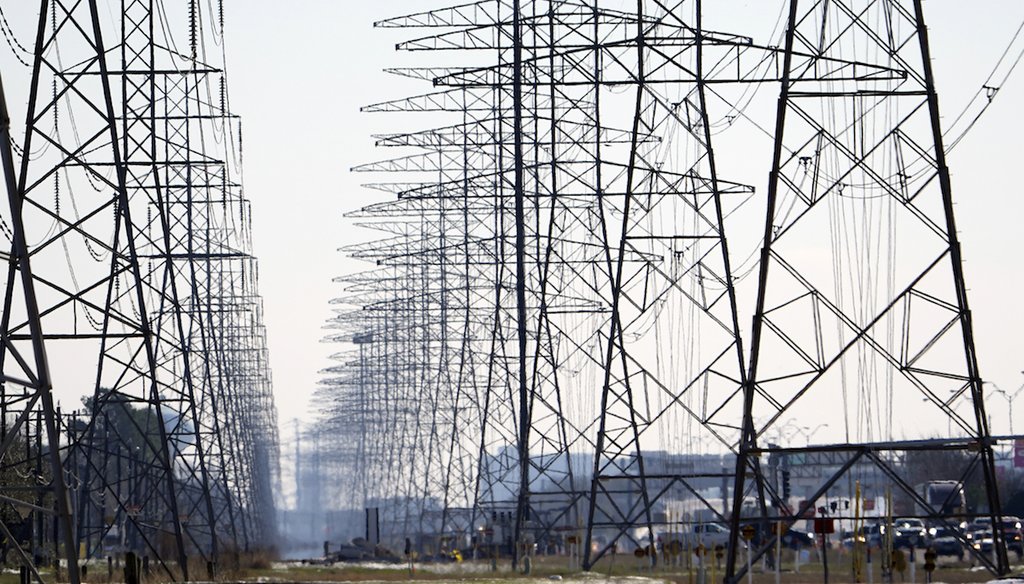Stand up for the facts!
Our only agenda is to publish the truth so you can be an informed participant in democracy.
We need your help.
I would like to contribute

Power lines in Houston. More than 4 million people in Texas still had no power a full day after a historic storm caused widespread blackouts. (AP Photo/David J. Phillip)
If Your Time is short
-
Of the power shortfall that hit Texas, over 80% was due to problems at coal- and gas-fired plants.
-
Wind farms ran at about half of what was expected.
When a rare blast of Arctic air and ice hit Texas and resulted in a massive power outage, the critics of wind power were quick to focus on the wind turbines that came offline. Supporters of wind power argued back that frozen turbines played a minor role in the outage.
Texas does have a bodacious amount of wind power. In winter, it supplies about 25% of the state’s electricity. And nearly half of that capacity shut down when ice coated the turbine blades. As residents tried to heat their homes, demand surged and the agency that manages the state’s power grid, the Electric Reliability Council of Texas, imposed rolling blackouts.
The question is, was the state’s reliance on wind power its Achilles’ heel? Did it fail to have enough gas and coal capacity to meet people’s needs during extreme conditions?
Sign up for PolitiFact texts
The numbers show that natural gas plants were the biggest cause of the power shortfall, not wind.
The state’s grid operator said Feb. 15 that about 34 gigawatts of power were offline. But of that, about 4 gigawatts was due to problems with wind turbines. The rest came mainly from the state’s primary sources, natural gas and coal.
Dan Woodfin, a senior director for the Electric Reliability Council of Texas, told Bloomberg that frozen gauges and instruments at natural gas, coal and nuclear plants cut into operations. Natural gas-fired plants also had to deal with low gas pressure in their supply lines.
"Those of you who have heard that frozen wind turbines are to blame for this, think again," tweeted Jesse Jenkins, engineering professor at Princeton University. "The extreme demand and thermal power plant outages are the principal cause."
It’s not as though the grid operators didn’t plan for winter troubles. But they hadn’t planned for an event as severe as this.
In their annual forecast, they predicted that demand would peak at about 67.2 gigawatts. On Sunday night, demand hit 69.1 gigawatts. Meanwhile, outages from coal and natural gas plants were at least 10,000 megawatts larger than they expected in their most extreme scenario.
To a certain extent, the wind turbines exceeded expectations. The grid operators predict a day in advance how much power the turbines will produce. At many hours of the day on Feb. 15 and Feb.16, wind delivered more power than the engineers at the Electric Reliability Council of Texas had expected.
Woodfin told the Austin American-Statesman that for the turbines that remained operational, strong winds were spinning the blades faster than usual.
Cold weather doesn’t have to curtail wind turbines. In northern states and Canada, turbines are more likely to be designed to shrug off cold and ice, because cold weather is a regular occurrence.
"You can use anti-icing methods," said Christopher Niezrecki, engineering professor at UMASS-Lowell. "It can be as simple as heaters built inside the blades."
But Niezrecki said for a rare storm like the one in Texas, that wouldn’t make sense.
"It’s alway about money and the capital expenditure," he said. "You build it for whatever events are likely. Why would you pay a lot more for a rare storm?"
Our Sources
Todd Starnes, tweet, Feb. 16, 2021
Electric Reliability Council of Texas, Load forecast vs actual, Feb. 16, 2021
Electric Reliability Council of Texas, Fuel mix report, January 2021
Electric Reliability Council of Texas, Generation, accessed Feb. 16, 2021
Electric Reliability Council of Texas, press release, Feb. 15, 2021
Electric Reliability Council of Texas, Seasonal Assessment of Resource Adequacy for the ERCOT Region (SARA) Winter 2020/2021, Sept.2, 2020
Electric Reliability Council of Texas, Seasonal assessments show sufficient generation for winter and spring, Nov.5, 2020
Tech Crunch, Severe weather, blackouts show the grid's biggest problem is infrastructure, not renewables, Feb. 15, 2021
Bloomberg, U.S. Power Crisis Leaves Millions Cold, Dark as Blackouts Expand, Feb. 16, 2021
Jesse Jenkins, tweet, Feb. 16, 2021
Boston Globe, Why is the power out in much of Texas? Frozen instruments at power plants, not wind farms, are the main factor, Feb. 16, 2021
Austin American-Statesman, Frozen wind turbines hamper Texas power output, state's electric grid operator says, Feb. 15, 2021
ArsTechnica, Texas’ power grid crumples under the cold, Feb. 15, 2021
Dallas Morning News, How did Texas wind up on its own electrical grid? Curious Texas investigates, Jan. 29, 2021
Interview, Christopher Niezrecki, professor and chair, Department of Mechanical Engineering, University of Massachusetts Lowell, Feb. 16, 2021
Interview, Mario Rotea, professor of mechanical engineering, University of Texas-Dallas, Feb. 16, 2021
Email exchange, Jesse Jenkins, assistant professor of Mechanical and Aerospace Engineering, Andlinger Center for Energy and the Environment, Princeton University, Feb. 16, 2021
Interview, Peter Fox-Penner, director of the Institute for Sustainable Energy, Boston University, Feb. 16, 2021












































